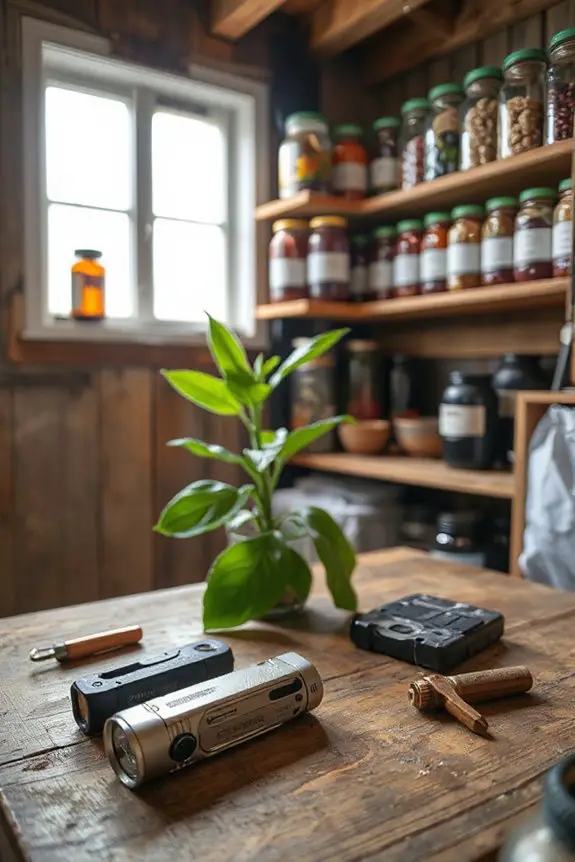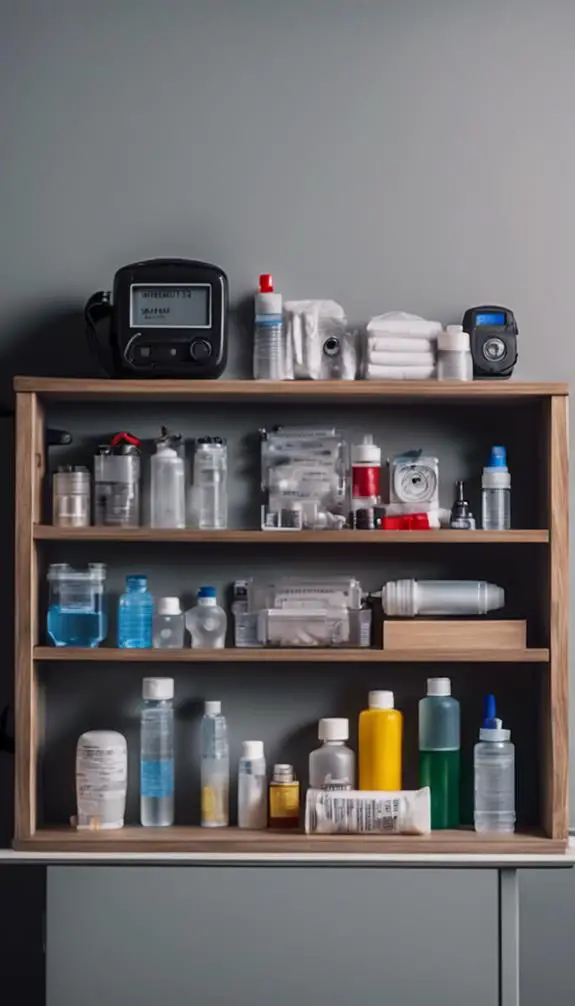So, you wanna start prepping, huh? Let’s cut the fluff. First things first: assess your risks. What’s lurking outside your door? Natural disasters? Economic meltdowns? Inventory your skills and resources. Grab the essentials—food, water, first aid kit—like you’re stocking a bomb shelter. But don’t just gather stuff; build a mindset of resilience. Think you’re ready? Hold that thought. There’s a whole lot more to tackle before you can call yourself a true prepper.
Summary
- Begin by assessing potential threats and risks in your area to tailor your prepping efforts appropriately.
- Create a basic emergency supply kit that includes food, water, first aid supplies, and essential tools.
- Develop essential survival skills such as first aid, fire-starting, and food preservation techniques to enhance self-sufficiency.
- Establish a budget for prepping to prioritize and allocate resources effectively for your needs.
- Foster community connections to share resources, skills, and support during emergencies for greater resilience.
Understanding the Basics of Prepping

When it comes to prepping, you might feel like you’re stepping into a wild, uncharted kitchen, but trust me, it’s not as scary as it sounds.
Think of it as sustainable living, a recipe for community resilience. You don’t need a PhD in survival skills! Start with the basics: food, water, and supplies. Stockpile what you eat, and don’t forget your first aid kit.
Ever thought about gardening? It’s not just for retirees; it’s a game-changer! Additionally, consider building an emergency fund to provide financial security during unexpected crises.
And hey, connect with others. Sharing skills and resources builds a fierce community. You’re not just prepping for you; you’re prepping for us.
Let’s rock this!
Assessing Your Risks and Needs

Alright, let’s get real about this: if you want to prep effectively, you’ve gotta start by figuring out what could go wrong in your world.
Natural disasters? Economic collapse? You name it, and you better be ready for it.
Then, take a good, hard look at what you’ve got on hand—your skills, supplies, and resources—because knowing your strengths is just as important as spotting the threats. Additionally, consider creating a budget for prepping to allocate resources effectively towards your essential needs.
Identify Potential Threats
What’s lurking in your backyard? Natural disasters, civil unrest, and economic collapse could knock on your door when you least expect it.
Technological failures? They’re not just sci-fi plots; they’re real threats. Health pandemics and environmental hazards can strike hard, turning your life upside down.
And let’s not forget personal safety—who’s got your back when community threats arise? Start by listing these risks. Be honest. What keeps you up at night?
A little fear can be a great motivator. So, gear up, sharpen your instincts, and get ready to face the chaos. You’ve got this! Additionally, it’s crucial to consider risk assessment in your planning to ensure you address all potential vulnerabilities effectively.
Evaluate Personal Resources
Before diving headfirst into the chaos of prepping, it’s essential to take stock of what you’ve got. I’m talking about a personal inventory—every can, tool, and skill.
What’s your resource assessment? Do you have enough food, water, and gear? Don’t just glance; dig deep!
Look around. What can you barter? What skills could save your bacon? Maybe you’re a whiz at fixing things or have gardening skills that could rival a farmer.
Your resources aren’t just supplies; they’re your lifeline. So, get real, get honest, and get ready. Prepping isn’t just for doomsday; it’s for everyday life, too. Make sure to include non-perishable food essentials in your inventory for a well-rounded approach to prepping.
Creating a Prepper Mindset

Creating a prepper mindset isn’t just about stashing away canned beans and bottled water; it’s about flipping the script on how you see the world.
It’s a mindset shift, folks! You’ve gotta embrace a survival philosophy that screams, “I’m in control!” Start questioning everything.
What if the power goes out? What if the grocery store shelves run dry? Think ahead, think sharp. Visualize scenarios, and plan your moves. Use your intuition—trust it.
This isn’t paranoia; it’s preparation. You’re not just a bystander; you’re the lead chef in your own survival kitchen. Prioritize staying warm and dry to ensure you can handle any unexpected challenges that may arise.
Building Your Emergency Supply Kit
Alright, listen up! Building your emergency supply kit isn’t just a chore; it’s your lifeline when chaos hits the fan.
I’m talking about a solid essential supplies checklist, food and water storage that wouldn’t make a college kid proud, and first aid essentials that could save your—or someone else’s—skin. Don’t forget to prioritize clean drinking water to ensure your family’s health and safety during emergencies.
Essential Supplies Checklist
When it comes to building your emergency supply kit, you’ve gotta get real—like, 10 items you can’t live without real.
First, grab a sturdy backpack for your emergency gear; it’s gotta hold everything. Next, you need a multi-tool—think Swiss Army knife on steroids.
Don’t forget a first-aid kit; band-aids alone won’t cut it. A flashlight and extra batteries? Non-negotiable.
Add a fire starter and paracord for survival tools. A whistle for signaling, duct tape for everything else, and a local map—you don’t wanna get lost.
Additionally, ensure you have reliable water purification methods to make sure you can access safe drinking water if needed.
Seriously, these essentials could save your life. So, what’re you waiting for? Get to it!
Food and Water Storage
Ready to talk about food and water storage?
First off, stock up on canned goods. They’re your best friend—long shelf life, minimal prep. Think beans, veggies, soups. You’ll thank me later when you’re not surviving on instant noodles.
Next, water. You can’t live without it, right? Invest in a solid water filtration system. Whether it’s a filter pitcher or a fancy gadget, just do it. Trust me, you don’t want to sip swamp water.
Keep a stash of both. Life’s unpredictable, but your pantry shouldn’t be. Prepping isn’t about panicking; it’s about being prepared.
First Aid Essentials
You never know when you might need it, but a well-stocked first aid kit can be the difference between a minor scrape and a full-blown crisis.
Grab a sturdy container and fill it with band-aids, antiseptic wipes, gauze, and pain relievers. Don’t forget tweezers for those pesky splinters!
And hey, include a list of emergency contacts—because when panic hits, we forget everything. It’s like our brains shut down.
Stay sharp: double-check expiration dates and replenish supplies regularly. Trust me, it’s better to be over-prepared than to scramble during an emergency.
You’ll thank me later!
Food Storage Strategies
Food storage isn’t just about shoving stuff in a pantry and crossing your fingers; it’s a tactical game. I’m talking long-term storage, people!
Buy in bulk, but don’t let that stash become a pantry graveyard. Use suitable containers for nutrient preservation, and for the love of all that’s tasty, control your climate.
A solid rotation system is key—don’t let old emergency rations haunt you! Embrace freeze drying and canning techniques like they’re your new best friends.
Keep an inventory management plan, and you’ll always know what you’ve got. Seriously, it’s not just food; it’s your survival strategy. Get to it!
Learning Essential Survival Skills
Alright, let’s get real about survival skills.
You can’t just pack a pantry and call it good; knowing basic first aid, how to start a fire without a match, and preserving food like a pro can save your bacon when things go sideways.
Basic First Aid Techniques
When disaster strikes—whether it’s a kitchen mishap or a full-blown emergency—knowing basic first aid can mean the difference between a minor hiccup and a major catastrophe.
Trust me, it’s not just about slapping on a bandage; it’s mastering bandage techniques, wound care, and CPR basics. Got a sprain? Time for splint application.
Your first aid kit better be stocked with medical supplies, and don’t forget triage principles for injury assessment—prioritize like a pro.
You want to be the first responder everyone looks to, not the one panicking. So, roll up those sleeves and get ready to save the day!
Fire Starting Methods
Got your first aid skills down? Good, ’cause now we’re talking fire! You gotta master flint methods. Grab a rock and spark it—easy, right?
But don’t forget friction techniques. Rub two sticks together like you’re trying to annoy someone. Patience is key here; it’s like waiting for water to boil. You want that sweet, sweet ember to glow.
And hey, if you get frustrated, just remember: fire’s not gonna start itself! Practice this stuff until you can do it blindfolded. It’s your lifeline.
No fire? No survival. So, get out there, ignite that spark, and show the world you mean business!
Food Preservation Skills
Food preservation skills? You bet! I’m all about mastering canning techniques to lock in flavor and shelf life.
Dehydrating foods? Essential for those emergency rations. Fermenting vegetables? Hello, gut health!
Don’t forget vacuum sealing; it’s a game changer. Preserving herbs can amp up your meals.
Root cellaring is like a cool, dark pantry miracle. Freezing methods are lifesavers, especially for meal planning and food rotation.
And pickling recipes? Yes, please! Food safety and nutrition considerations are non-negotiable.
Bulk purchasing? Smart move. So, roll up your sleeves and get to work—your future self will thank you!
Establishing a Communication Plan
You might think a communication plan is just a fancy term for a group chat, but trust me, it’s way more than that.
You need clear communication tools, like text alerts or walkie-talkies, to keep everyone on the same page when chaos hits. Write down your emergency contacts—everyone from Aunt Edna to your neighbor, Bob.
Create a shared document, or even a good old-fashioned list. Practice this plan regularly, so it’s second nature.
What’s the point of prepping if you can’t reach your crew? When things go sideways, you’ll be damn glad you laid this groundwork ahead of time.
Developing a Bug-Out Plan
When the world turns upside down, where the heck are you gonna go? You need a solid bug-out plan, pronto!
Pick your bug out locations—think remote cabins or trusted friends’ homes. Map out evacuation routes like a treasure hunt. Don’t forget emergency contacts; they’ll be your lifeline.
Transportation options? Have a reliable vehicle ready. Shelter plans should be nailed down in advance, so you’re not scrambling.
Safety protocols? Know ‘em like the back of your hand. Communication strategies? Use them wisely. And always, always have contingency plans.
Connecting With the Prepper Community
So, how do you immerse yourself in the prepper community without feeling like a fish out of water?
Engage in community events and local meetups. Trust me, nothing beats face-to-face skill sharing.
Check out online forums for those late-night questions—people are keen to help!
Tune into prepper podcasts while cooking or cleaning; they’re goldmines of info.
Don’t forget social media for resource exchanges.
Want hands-on experience? Join group training or survival workshops.
And keep an eye out for mentorship opportunities; they’re often hidden gems.
Get involved, stay curious, and don’t just watch—jump in! You’ll thank yourself later.
Regularly Reviewing and Updating Your Preps
Immersing yourself in the prepper community is just the start; now it’s time to get serious about what you’ve got stashed away. A solid prepping schedule is your best friend.
Trust me—don’t just shove supplies in a corner and forget about ‘em! Grab a review checklist, and plunge into it. Check expiration dates, rotate your food, and reassess your gear.
What worked last year mightn’t cut it now. Need a new first aid kit? Get it. This isn’t a hobby; it’s survival.
FAQs
What Types of Disasters Should I Prepare for First?
You want to know what disasters to prep for? Let’s get real.
First up, natural disasters—earthquakes, hurricanes, floods. They don’t mess around.
Then, everyday emergencies like power outages or job loss. Yeah, those sneak up on you.
I’m not saying you need a bunker, but having a plan is smart. Stock up on essentials, keep it simple.
Don’t wait. When chaos hits, you’ll be grateful you did something. Trust me.
How Much Money Should I Budget for Prepping?
Alright, let’s cut to the chase about budgeting for prepping.
You’ve gotta carve out some emergency funds, right? I’m talking about a solid base—start with at least $500, but aim for more if you can.
Prioritize what you need first: food, water, gear. Don’t blow it all on fancy gadgets! Keep it real, focus on essentials.
And hey, if you find a good deal, snag it! What’s your prepping game plan?
Can I Start Prepping on a Tight Budget?
Absolutely, you can start prepping on a tight budget! I’ve done it.
Look for budget-friendly supplies like canned goods, bulk grains, and DIY tools. Hit up local thrift stores or online marketplaces for low-cost resources.
Seriously, you don’t need to break the bank. Got a tight wallet? No problem. Just think smart.
Stock up gradually, and don’t underestimate the power of a little creativity. Prepping isn’t about fancy; it’s about being ready.
What Are the Best Resources for Learning Survival Skills?
Wanna learn survival skills? Grab some survival books—they’re gold!
I love digging into a good read that slaps me with knowledge. Online courses? Don’t sleep on those! They’re interactive, and you can learn from the couch.
YouTube’s a treasure trove, too—just watch out for the wannabes. Trust me, a mix of books and courses keeps your skills sharp.
How Do I Involve My Family in Prepping?
Involving your family in prepping isn’t just smart—it’s a bonding experience.
Try family activities like camping or cooking survival meals together. Get everyone involved!
Talk about the prepping mindset during dinner, and make it a regular topic.
Create a family plan that’s not just a checklist but a fun challenge.
Who can build the best bug-out bag? Spice it up!
Trust me, you’ll laugh, learn, and maybe even argue a bit.
Conclusion
So, are you ready to plunge into prepping? It’s not just about stashing supplies; it’s about taking charge of your life. Don’t wait for a disaster to hit—get your gear together, connect with your neighbors, and build that emergency fund. You’ve got this! Remember, it’s not about fear; it’s about empowerment. So roll up your sleeves, embrace the chaos, and prep like your life depends on it. Because, spoiler alert: one day, it just might.




